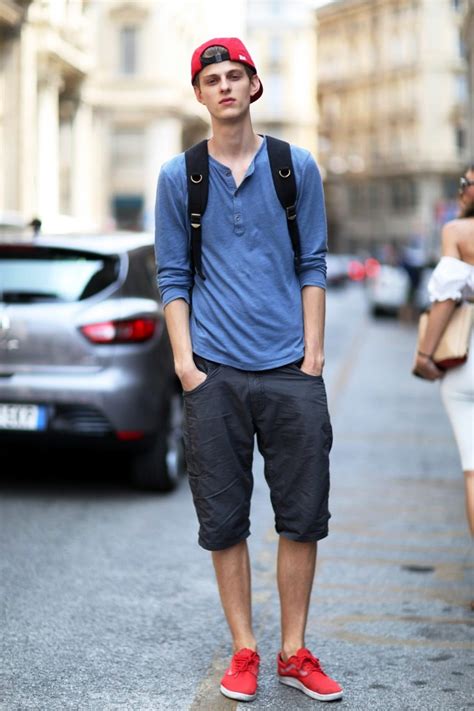Fashion is not confined to the runways and glossy magazine pages anymore. It has expanded into the streets, where real people express their individuality through their personal style choices. Street style has become a powerful force in shaping contemporary men's fashion, challenging traditional norms and inspiring new trends. This essay will explore the influence of street style on men's fashion, highlighting its evolution, key elements, and its impact on the industry.

Street style can be defined as the fashion trends and styles that originate from everyday people on the streets rather than from high-end designers or fashion houses. It encapsulates the way ordinary individuals interpret and reinterpret fashion, showcasing their personal style and creativity. Although street style has existed for decades, it gained prominence in the late 20th century, particularly in urban areas, where subcultures and youth-driven fashion movements began to flourish.
One of the most influential subcultures that emerged from street style was the rise of hip-hop culture in the 1970s and 1980s. Hip-hop music and its accompanying fashion choices influenced an entire generation and continue to do so today. Oversized clothing, baggy jeans, graphic t-shirts, and sneakers became hallmarks of street style, reflecting the rebellious and expressive nature of hip-hop culture. Artists like Run-D.M.C., Tupac Shakur, and Notorious B.I.G. became powerful style icons, shaping the way young men dressed and influencing mainstream fashion.
As street style evolved throughout the 1990s and early 2000s, other subcultures and fashion movements gained traction. Skateboarding culture, for instance, brought a laid-back and effortlessly cool aesthetic to the streets. Men began to embrace oversized hoodies, loose-fitting pants, and skate shoes, blurring the lines between comfort and style. Skateboarders like Tony Hawk and brands like Supreme and Palace became synonymous with the merging of street style and high fashion.
The rise of social media in the late 2000s and early 2010s further catapulted street style into the spotlight. Platforms like Instagram allowed individuals to showcase their personal fashion choices and gain a following. Influencers and bloggers became powerful tastemakers, capturing the attention of both the fashion industry and the general public. These style icons, often hailed as street style stars, showcased unique combinations of high-end designer pieces with more accessible fashion, blurring the distinction between luxury and streetwear.
Key elements of street style in contemporary men's fashion include the fusion of high and low fashion, the emphasis on individuality, and the incorporation of subcultural influences. The blending of high-end luxury brands with more affordable streetwear has become a defining characteristic of modern street style. Men are no longer bound by the constraints of wearing head-to-toe designer attire. Instead, they mix high fashion pieces with vintage finds, thrifted items, and streetwear brands, creating a unique and eclectic style that reflects their personality and taste.
Individuality is another crucial element of street style. Rather than following strict fashion rules, men are encouraged to express themselves through their clothing choices. This freedom has led to a more diverse and inclusive fashion landscape, where different body types, styles, and backgrounds are celebrated. Street style has become a platform for self-expression, challenging societal norms and the limitations set by traditional fashion industry standards.
Subcultural influences continue to shape contemporary men's street style. From punk and grunge to biker and skater culture, the aesthetics of these subcultures have found their way into mainstream fashion. Men can be seen wearing leather jackets, ripped jeans, band t-shirts, and combat boots - all elements borrowed from subcultures that originated on the streets. These influences infuse street style with an edginess and authenticity that sets it apart from more commercial and polished fashion trends.
The impact of street style on men's fashion cannot be overstated. It has become a driving force that challenges traditional fashion norms, pushes boundaries, and encourages experimentation. High fashion designers and brands have taken notice of street style's influence and have started collaborating with streetwear labels and incorporating street-inspired elements into their collections. Luxury fashion houses like Gucci, Balenciaga, and Off-White have embraced streetwear aesthetics, blurring the lines between high fashion and street style even further.
The influence of street style is also evident in the rise of sneaker culture. Once seen as athletic footwear, sneakers have become a staple in everyday fashion, embraced by men of all ages and style preferences. Sneaker collaborations between major fashion brands and sneaker enthusiasts have become highly sought-after and have turned sneaker collecting into a significant part of contemporary men's fashion culture.
Furthermore, the democratization of fashion through street style has led to a shift in power dynamics within the industry. The gatekeepers of fashion are no longer solely fashion editors and high-profile designers. Ordinary individuals on the streets, with a unique sense of style and a social media following, have the power to influence trends, gain partnerships with brands, and even become designers themselves. This democratization has created a more inclusive and diverse fashion landscape, challenging the conventional hierarchy and giving a voice to those who were previously marginalized.










Leave a Reply